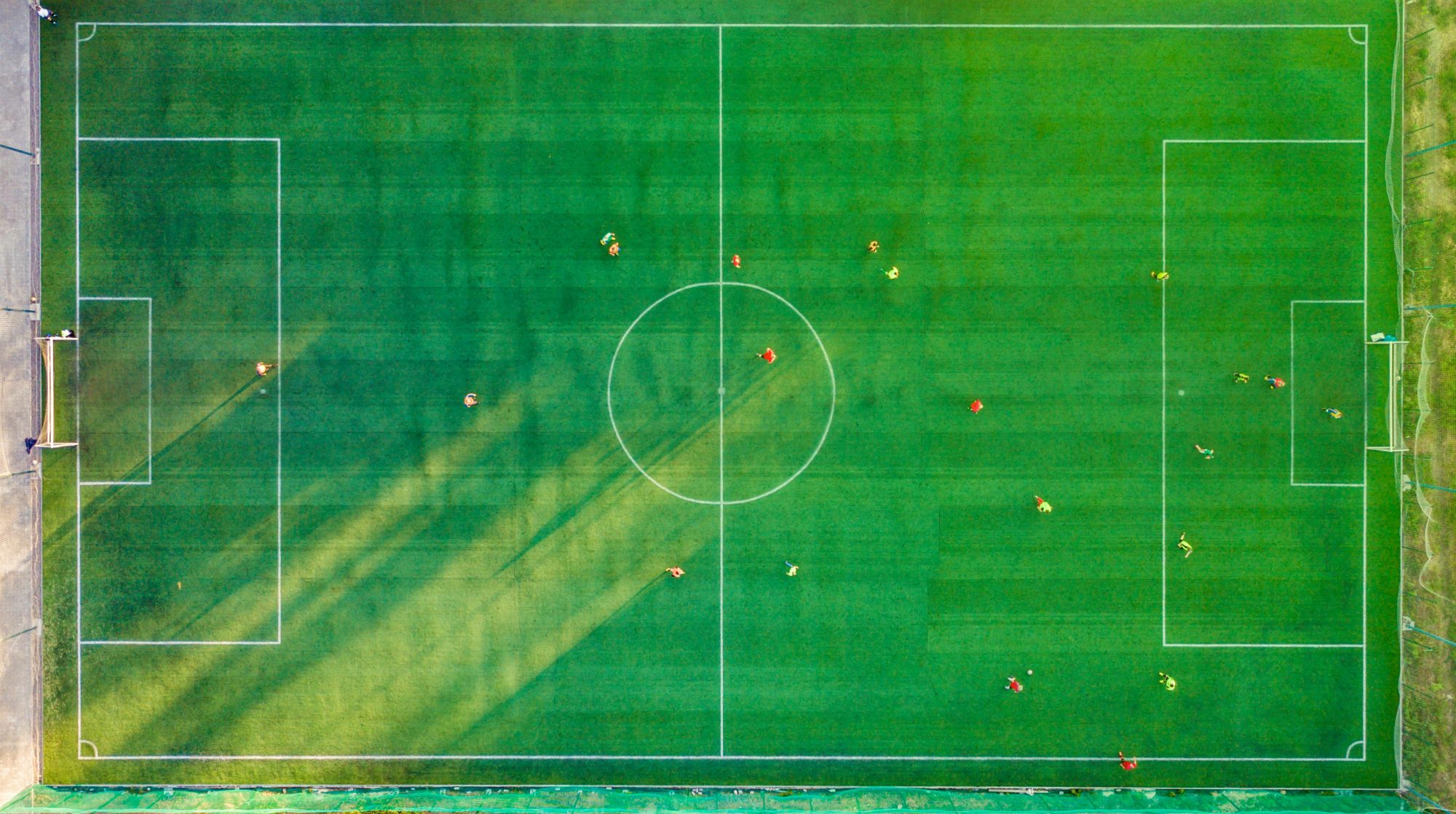After Roy Hodgson’s retirement from the game, many thought Crystal Palace were doomed for relegation. However, with a couple of new signings and a more energetic, attack-minded style of play, Patrick Vieira has taken Palace to new heights. While they sit just tenth place in the table, Vieira’s Eagles have now gone unbeaten in their last six matches, including a massive 2-0 win to set title-contenders Manchester City back a peg. Even in matches they’ve lost the season, the signs of what’s to come from Palace in the future are promising. So with that, here is a tactical analysis of Patrick Vieira’s new-look Crystal Palace.
system of play: 4-3-3 / 4-2-3-1

Patrick Vieira’s first showing of a positive, new brand of football came right from the very first match against Chelsea, with Palace operating in a 4-3-3 formation. While Vieira’s side were battered on the day by the Blues, it’s clear that the former Arsenal legend has maintained Hodgson’s defensive solidity, whilst encouraging a greater emphasis on possession and clear principles of play in attack. His formation has been integral to the balance of the team, operating very much like a 4-1-4-1 or 4-2-3-1 in defense, and more so like a 4-2-3-1 or 4-1-4-1 in attack, as Conor Gallagher pushes on and looks to connect with the front three. Lampard-esque in his play, Gallagher’s box to box mobility has been integral to the success of the team. Normally so Zaha reliant, Palace have been able to emphasize other characters this season, catering toward Christian Benteke and the fantastic work rate of the Chelsea loanee.
But Gallagher isn’t the only new signing that’s fit in right away. Vieira’s had much success deploying two brand new centre-backs – Joachim Andersen, who was a standout for relegated Fulham last season, and Marc Guehi, who’s also come in from Chelsea after a successful season on loan with Swansea. Both players fit the Palace mold of being good in the air and solid defensive shufflers, but they also fit the Vieira mold of being good in possession and better out from the back than some of Palace’s former men. Having two formidable centre-backs who have the durability and youth to play every game has also allowed Cheikhou Kouyate a return to his normal position, where he’s excellently anchored the midfield line. James McArthur’s also retained his place despite the change in manager, taking on the armband and playing a more forward-thinking box-to-box role this season.
Jordan Ayew’s continued to feature heavily, often playing on the right of the front three, but the form of Christian Benteke has been perhaps most impressive, as the team have been able to play to his strengths through an increase in possession, wide play, and crossing. Wilfried Zaha’s continued as the clear star of the team, but he has more back-up now in Odsonne Edouard, and the aforementioned Conor Gallagher. They’ve scored 11 goals between the three of them in just 11 matches so far, contributing massively to Palace’s tally of 15 goals this season. Edouard’s versatility is particularly key to Vieira’s shape, as he can play as either a striker or on the left wing depending on the type of striker Vieira wants to deploy on a game by game basis. All and all, it’s clearly a much improved Palace squad since the days of Roy Hodgson, and that is helping the Eagles soar up the table into the top half, where they can finally show a more exciting brand of football. Through all of it, they’ve been both functional and versatile in changing their shape and structure based on the moment, building around a 4-3-3 formation that plays to the strengths of Gallagher. So let’s get into more of exactly how Palace have gone from Zaha-reliant, to much more than that under the influence of Patrick Vieira.
changing shapes & gallagher’s role
Embed from Getty ImagesThe functionality of Vieira’s changing shapes within his 4-3-3 showcases signs of an astute manager, who already has a keen understanding of his players. As already mentioned, the 4-3-3 may look like a 4-2-3-1 or 4-3-3 in defense depending on the opposition’s positioning. When opposition sides are keeping more of the ball in their own third or with their centre-backs, it’s more likely to be a 4-2-3-1, as Gallagher pressures and Benteke remains lurking in the background as an instant outlet in transition. Lower on the field, unsurprisingly, it can be more 4-3-3 or even 4-1-4-1, as Gallagher then slots into the right half-space. In attack, it frequently becomes 4-2-3-1, with Conor Gallagher stepping out to support the striker and looking to receive in between the lines during Palace’s build-up. McArthur also often pushes up during initial build-up phases, giving Palace a 4-1-4-1 shape. Then when they lose the ball in the opposition’s third, either the 4-2-3-1 or 4-1-4-1 may remain, as Palace counter-press and look to win the ball back right away. This has put the Chelsea loanee at the forefront of Vieira’s tactics, as he becomes a key focal point for the team. Not only is Gallagher the most active presser for Palace, he’s also the most creative attacker – highlighting his box-to-box role and overall importance.
His penalty box instincts and goal-scoring touch have also helped turn the 21-year-old into one of the most dangerous attackers in the league. Gallagher knows exactly the moment to drift into the penalty area, often arriving late to provide something more for the lightning quick Zaha who finds himself double teamed in a wide area, or for Benteke who holds up the play and tries to bring others into the game. Gallagher’s made himself a perfect match for both players, and gives Palace somewhat of a throwback to the old-school 4-4-2 that incorporated a smaller player bouncing off of a taller one. Speaking of “bouncing”, he’s also a nuisance for opposition defenders with his surprising mix of tidy footwork in tight spaces and strength to shield the ball away from them. He’s won himself 2 fouls per game, which in the future could result more and more into goals for the Eagles. For now, Palace are yet to score from a set-piece, as they’ve instead become more about excellent team-play in the final third. In the past, opposition teams often looked to get touch-tight to Wilfried Zaha…even double-team him. Now their attempts to continue those kinds of efforts are more likely to turn fruitless, as Palace are much more than just a one-man team. It’s now Gallagher taking the bulk of their chances, with 2.3 shots per game. With 4 goals in 10 matches, the Chelsea loanee is currently on track to finish the season well into double figures. Zaha’s matched that tally, meaning he’s still a key focal point for the team, just not the only one.
possession & purpose
Embed from Getty ImagesThe most positive of all changes from Hodgson’s Palace to Vieira’s is the increase in possession. Under Hodgson, Palace were strictly a counter-attacking team, that didn’t want much to do with the ball. They kept just 43% possession in their matches last season, compared to a massively different 51.3% this time around – the ninth highest in the league. Their passing percentage has also gone up from 76% to 82%, which showcases a more purposeful mantra rather than a hopeful, pass it forward and see what happens mentality.
Impressively, Vieira’s turned James McArthur into a more progressive, active attacking member. The Scottish midfielder’s numbers in both progressive passes and passes into the final third have gone way up, and he’s become increasingly important to their build-up. Under Hodgson, build-up did not even exist. Gallagher meanwhile is more of a progressive carrier, and his high starting position means that he’s often the one pulling the strings further forward. Kouyate’s role has remained a more defensive one, shuffling with the play and providing balance between the other two. The centre-backs often skip him entirely during build-up phases, going wide to the fullbacks or between the lines to others higher up instead. With this mighty midfield triad, Palace’s dominance in central areas has been hard to top. With a focal point in attack, a decent attack-minded left-back, and two quality wingers in Zaha and Edouard, Palace have had no issue in then progressing into the opposition’s third to work their magic. Their possession increase has been impressive, but Vieira hasn’t lost any sense of the purpose in making this change. In fact their number of shots per game has unsurprisingly increased, going from 9.2 to 11.1 this season. Overall, Palace have improved massively in possession under Vieira, which has contributed to their recent rise up the table.
cONCLUSION
Embed from Getty ImagesCrystal Palace have been flying high under Patrick Vieira, under a new-look, new brand of football. Their possession stats and purpose in possession have been one of the most noticeable of changes, but their over-reliance on Zaha has also diminished with some new faces entering the frame. Instead of Zaha doing it on his own, Conor Gallagher’s become the key man for the Eagles, in both attack and defense. James McArthur’s become a more progressive passer, the defensive solidity has actually solidified under some new faces, and Palace are no longer an “ugly” team to watch. Whether or not Vieira can maintain this run of form and oversee a top half finish remains to be seen, but for now, Crystal Palace have been immensely impressive.
So there it is! A tactical analysis of Patrick Vieira’s Crystal Palace. Be sure to check out more of our analyses, and follow on social media via the link below. Thanks for reading and see you soon!
Why Jesse Marsch is perfect for the Canadian Men’s National Team
The American coach made his name across an incredibly successful spell at RB Salzburg between 2019-2021, but hasn’t been able to hold down the fort since. His brief stints at RB Leipzig and Leeds United showed signs of promise, but also many moments of doubt. So with Marsch being out of a top-tier job for…
Pep Guardiola – Manchester City – Tactical Analysis (2023-24)
This might finally be the year. It might finally be the year that Pep Guardiola and Manchester City don’t win the Premier League. Despite that, they’ve still been the most tactically complex team in the league, carrying on from much of the tactics that brought them a treble-winning triumph last season. Here is what Pep…
Game of Numbers #38 – Alejandro Garnacho’s intensity & awareness
It’s amazing to think that Alejandro Garnacho is only 19 years of age. Sometimes, you can see the rawness in his game. The facets that still need to be carefully developed. But as he ages, let’s hope he never loses his tenacity. His hunger for more. His appetite to win at all costs, even when…





10 thoughts on “Patrick Vieira – Crystal Palace – Tactical Analysis”